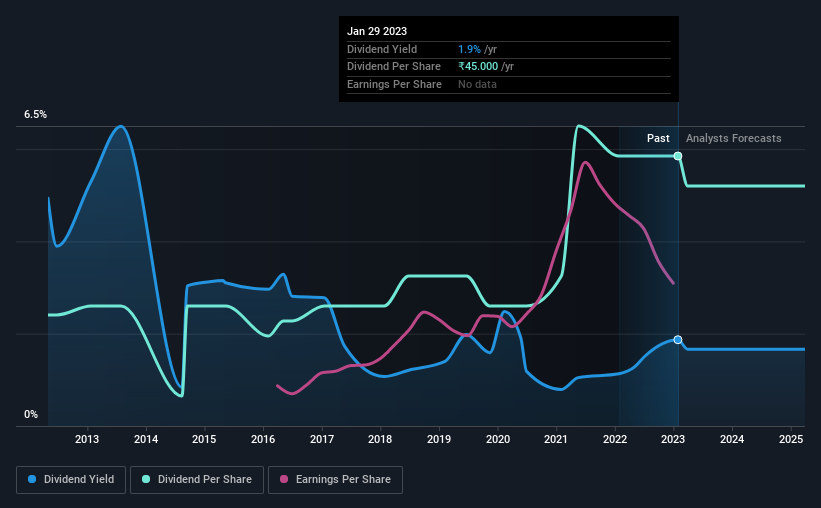The board of HIL Limited (NSE:HIL) has announced that it will pay a dividend of ₹20.00 per share on the 26th of February. Based on this payment, the dividend yield on the company's stock will be 1.9%, which is an attractive boost to shareholder returns.
Check out our latest analysis for HIL
HIL's Payment Has Solid Earnings Coverage
We like to see robust dividend yields, but that doesn't matter if the payment isn't sustainable. Based on the last payment, HIL was paying only paying out a fraction of earnings, but the payment was a massive 150% of cash flows. While the business may be attempting to set a balanced dividend policy, a cash payout ratio this high might expose the dividend to being cut if the business ran into some challenges.
Looking forward, earnings per share is forecast to rise by 138.0% over the next year. If the dividend continues on this path, the payout ratio could be 17% by next year, which we think can be pretty sustainable going forward.

Dividend Volatility
The company's dividend history has been marked by instability, with at least one cut in the last 10 years. The dividend has gone from an annual total of ₹18.50 in 2013 to the most recent total annual payment of ₹45.00. This means that it has been growing its distributions at 9.3% per annum over that time. It's good to see the dividend growing at a decent rate, but the dividend has been cut at least once in the past. HIL might have put its house in order since then, but we remain cautious.
The Dividend Looks Likely To Grow
Growing earnings per share could be a mitigating factor when considering the past fluctuations in the dividend. HIL has seen EPS rising for the last five years, at 16% per annum. Growth in EPS bodes well for the dividend, as does the low payout ratio that the company is currently reporting.
In Summary
Overall, we don't think this company makes a great dividend stock, even though the dividend wasn't cut this year. With cash flows lacking, it is difficult to see how the company can sustain a dividend payment. This company is not in the top tier of income providing stocks.
It's important to note that companies having a consistent dividend policy will generate greater investor confidence than those having an erratic one. Meanwhile, despite the importance of dividend payments, they are not the only factors our readers should know when assessing a company. For instance, we've picked out 2 warning signs for HIL that investors should take into consideration. Looking for more high-yielding dividend ideas? Try our collection of strong dividend payers.
Valuation is complex, but we're here to simplify it.
Discover if BirlaNu might be undervalued or overvalued with our detailed analysis, featuring fair value estimates, potential risks, dividends, insider trades, and its financial condition.
Access Free AnalysisHave feedback on this article? Concerned about the content? Get in touch with us directly. Alternatively, email editorial-team (at) simplywallst.com.
This article by Simply Wall St is general in nature. We provide commentary based on historical data and analyst forecasts only using an unbiased methodology and our articles are not intended to be financial advice. It does not constitute a recommendation to buy or sell any stock, and does not take account of your objectives, or your financial situation. We aim to bring you long-term focused analysis driven by fundamental data. Note that our analysis may not factor in the latest price-sensitive company announcements or qualitative material. Simply Wall St has no position in any stocks mentioned.
About NSEI:BIRLANU
BirlaNu
Engages in the production and distribution of building materials and other solutions in India and internationally.
Undervalued with moderate growth potential.
Similar Companies
Market Insights
Community Narratives



